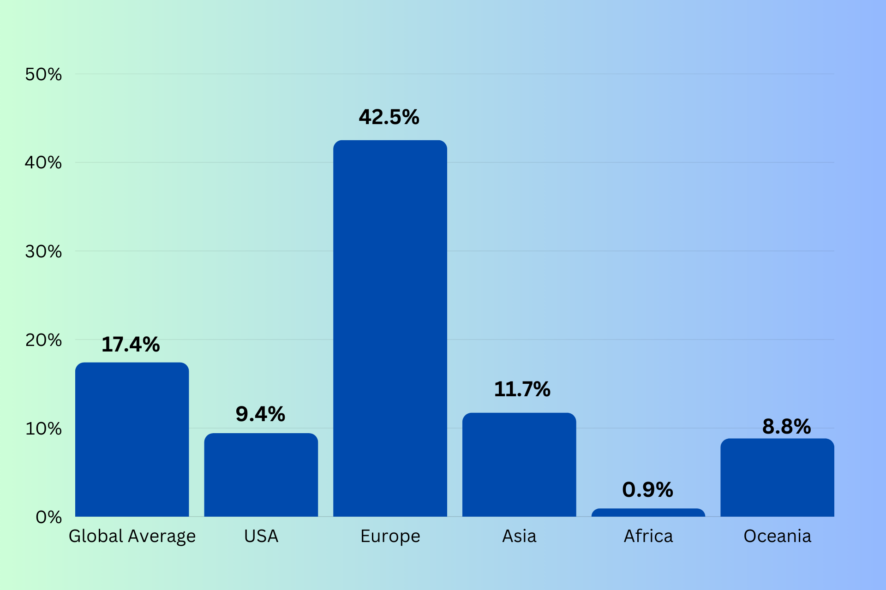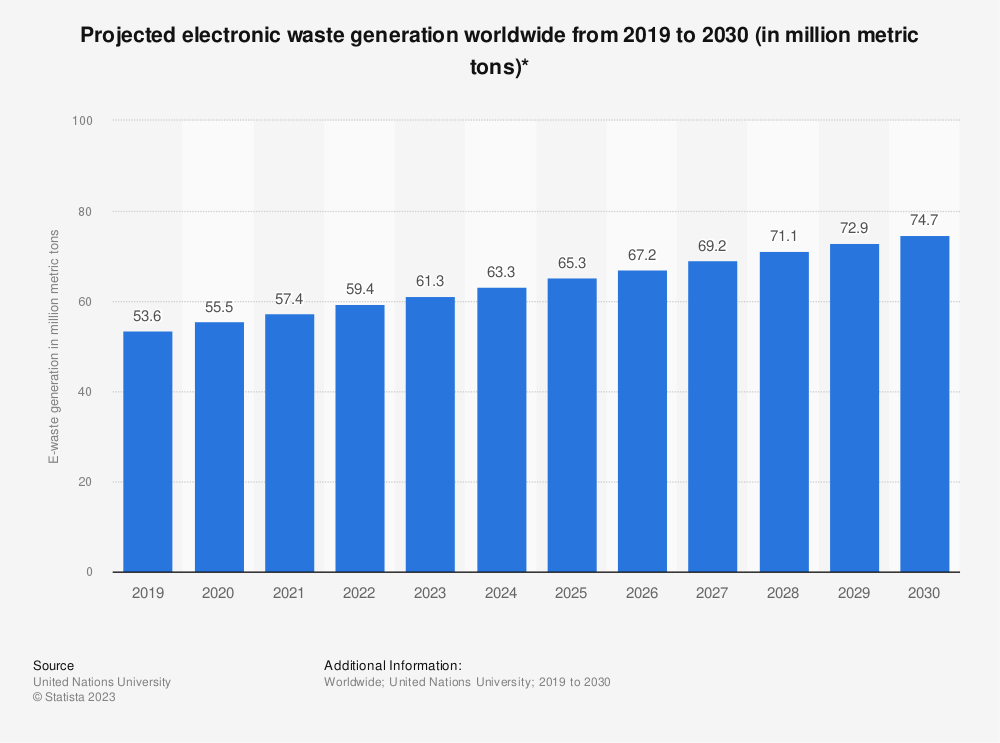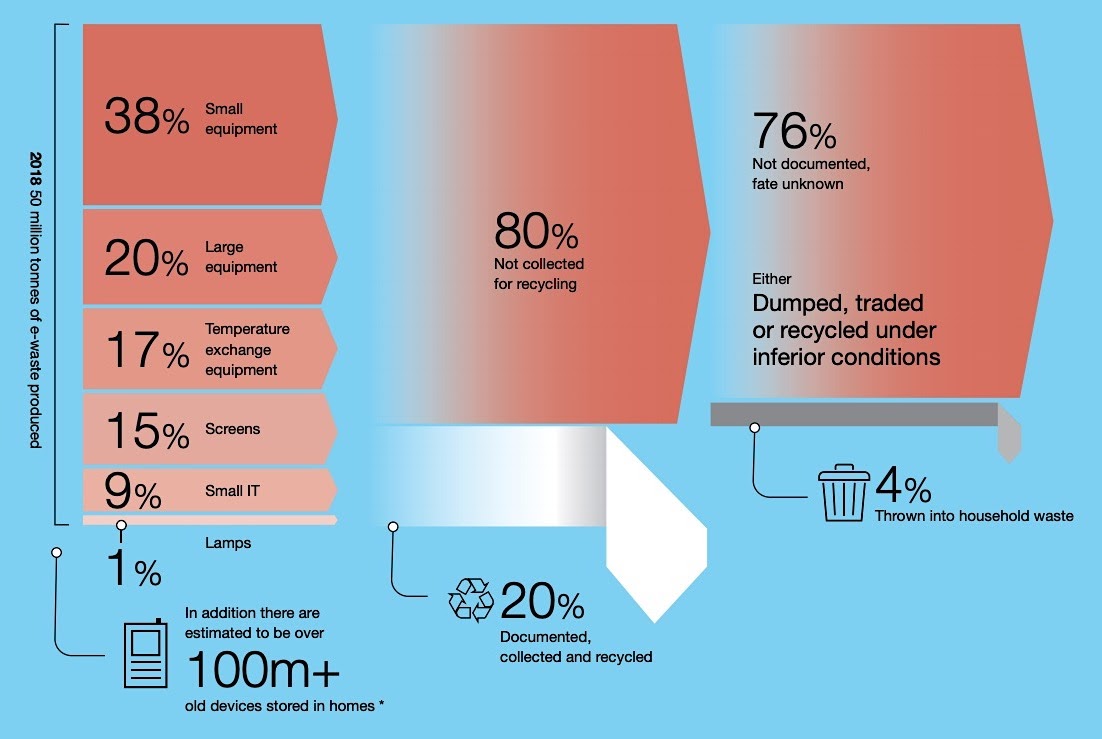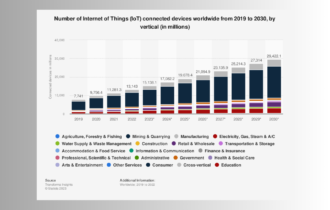Electronic Waste: Statistics & Facts You Won't Believe
E-Waste Odyssey: Peeling back the surprising layers of digital debris
10 min. read
Updated on
Read our disclosure page to find out how can you help Windows Report sustain the editorial team. Read more
Key notes
- 57.4 Million Metric Tonnes of e-waste was generated in 2021.
- China, the United States, and India are the leading e-waste producers in the world.
- To know more such mind-boggling facts, continue reading.

With each passing year and a growing population, the demand for electronic devices continues to surge. Therefore, manufacturers are bound to produce new models with the latest features to keep their customers engaged.
However, have you ever considered the fate of discarded devices – the ones that can’t be repaired or are thrown away by you or others? Well, it all amounts to e-waste, and unfortunately, only a small percentage of it gets recycled. The rest sits idle, polluting our environment.
In this comprehensive guide, we will delve into electronic waste statistics and facts that may make you rethink your habits and reflect on the implications of your digital footprint.
Why is electronic waste a growing problem?
- Rapid technological advancements.
- Growing consumer demand and change in consumer behavior.
- Lack of disposal infrastructure and limited recycling initiatives.
- Irresponsible manufacturers.
Electronic Waste Statistics and Facts
A report on Statista states that Asia is the largest e-waste producer worldwide, producing 24.9 Million Metric Tons of electronic waste in 2019, twice the amount of waste produced by Americas, and only 11.7% of this waste was collected and recycled.
| Continents | E-Waste (Million Metric Tons) |
| Asia | 24.9 |
| Americas | 13.1 |
| Europe | 12 |
| Africa | 2.9 |
| Oceania | 0.7 |
According to the Global E-waste Statistics Partnership, as of 2019, the average global electronic waste generated per capita is 7.3 kilograms, which is the largest volume recorded. In the same year, the global e-waste generation was approximately 53.6 million metric tons.
In 2019, Norway generated the largest amount of e-waste per capita worldwide, i.e. 28.5 kilograms.
Electronic Waste Statistics – Metric tonnes of E-Waste produced annually
From 2010 to 2019, electronic waste generation increased by approximately 60%, and there are no signs of slowing down. It is forecasted that by 2030, the annual e-waste production will reach up to 75 million metric tons.
There is more than 347 million metric tonnes of unrecycled e-waste on Earth in 2023.
If we talk about the amount of electronics waste produced country-wise, China, with 10129 thousand metric tons, is the leading nation, followed by the United States, with 6918 thousand metric tons. Here are other details:
| Country | Volume of waste in thousand metric tons | Recycling Rate |
| China | 10129 | 16% |
| United States | 6918 | 15% |
| India | 3230 | 1% |
| Japan | 2569 | 22% |
| Brazil | 2143 | 0% |
| Russia | 1631 | 6% |
| Indonesia | 1618 | – |
| Germany | 1607 | 52% |
| United Kingdom | 1598 | 57% |
| France | 1362 | 56% |
According to a report by World Economic Forum, electronic waste is 20% of all global waste and this number is estimated to increase up to 30% by the year 2025.
Approximately 12.9 million women are working in the informal waste sector, which puts them and their unborn children at risk of exposure to toxic e-waste.
Most Common Types of E-Waste
- Small equipment (17.4 Mt) – Microwaves, Fans, Vacuum Cleaners, Kettles, Shavers, Radios, Toasters, toys, and tools.
- Small IT & telecoms equipment (4.7 Mt) – Phone cases, Wireless Routers, Keyboards, Cell Phones (Mobile phones), e-readers, and Pocket calculators.
- Large equipment (13.1 Mt) – Tumble dryers, Cookers, Washing Machines, Stoves, and Dishwashers.
- Screens and monitors (6.7 Mt) – Monitors, Televisions, Notebooks, Laptops, and Tablets.
- Lamps, bulbs, and LEDs – 0.9 Mt
- Temperature Exchange Equipment (10.8 Mt) – Freezers, Air conditioners, Refrigerators, and Heat Pumps.
Here is the data on E-waste generated by countries in these categories:
| Categories | United States | Japan | Russia | United Kingdom |
| Total waste (2021) (Thousand tonnes) | 7136.3 | 2579 | 1691.8 | 1658.719 |
| Temperature exchange equipment | 1276.9 | 512.8 | 403.4 | 219.388 |
| Screens and monitors | 881.5 | 293.5 | 157 | 140.382 |
| Lamps | 73.5 | 27.4 | 23.8 | 10.559 |
| Large equipment | 1716.3 | 688.8 | 483.8 | 642.169 |
| Small equipment | 2447.4 | 825.8 | 507.1 | 489.682 |
| Small IT and telecommunication equipment | 740.8 | 230.5 | 116.6 | 156.539 |
Percentage of E-Waste recycled
Countries like Estonia, Norway, and Iceland have the best e-waste recycling rates in terms of waste percentage produced by the country.
| Rank | Country | E-Waste Recycled (Kt) | Recycling Rate |
| 1 | Estonia | 13 | 76% |
| 2 | Norway | 99 | 72% |
| 3 | Iceland | 5 | 71% |
| 4 | Sweden | 141 | 70% |
| 5 | Austria | 116 | 69% |
| 6 | Switzerland | 123 | 63% |
| 7 | Finland | 65 | 61% |
| 8 | Poland | 246 | 60% |
| 9 | Ireland | 52 | 59% |
| 10 | UK | 871 | 57% |
More than 82% of electronic waste is not recycled and therefore not documented and tracked where it ends up.
The global average of e-waste recycled is approximately 17.4%, and here is the data on e-waste cycled for different regions:
| Region | E-waste recycled (Percentage) |
| USA | 9.4% |
| Europe | 42.5% |
| Asia | 11.7% |
| Africa | 0.9% |
| Oceania | 8.8% |
Value of Raw Materials in Electronic Waste
Electronic waste consists of a large amount of valuable material that can be recovered through recycling and reused to make new products, thereby reducing the demand for perishable resources to an extent.
The latest report on Electronic Waste statistics states approximately $57 billion worth of recoverable precious metals are estimated to be contained in unrecycled e-waste.
If you’re interested, also check out how many computers are there in the world and the potential for the number to increase in the near future.
Precious Metals Found in Electronics
From precious metals like Gold, Silver, Platinum, and Palladium, base metals like Copper, Tin, Aluminium, Nickel, Steel, Iron, Plastics, Lead, Mercury, Cadmium, and glass to rare earth metals like Neodymium, Europium, and Yttrium can be found in e-waste lying around on some dumpster land.
If we recycle a million cell phones, we could collect 75lb of Gold, 772lb of Silver, 35247lb of Copper, and 33lb of Palladium.
As of now, only 5% Platinum, 15% Silver, and 15% Gold are being recovered during the recycling process. If the number reaches 100%, we can generate $12 billion.
Recycling the e-waste through proper channels and extracting these materials will not only keep the environment safe but also be economically beneficial.
By recycling 1 million laptops, we can conserve energy equal to the electricity consumed by 3,500 houses per year.
According to the EPA, one metric ton of circuit boards can contain 40 to 800 times more Gold and 30-40 times more Copper than what can be mined from one metric ton of ore in the United States.
Long-term Environmental Impact from Unmanaged E-Waste
- Toxic substance release – E-waste contains hazardous materials like Lead, Cadmium, Mercury, and brominated flame retardants, when not treated right, can leach into soil & water, contaminating the local ecosystem and posing health risks for both humans and wildlife.
- Air pollution – Burning e-waste improperly can release toxic particulates & fumes into the air, which could cause illness-related respiration among the habitants.
- Soil & water contamination – Dumping e-waste informally can contaminate soil and groundwater, affecting its agricultural properties, which poses a threat.
- Climate change – The breakdown and decay of organic materials are the results of improper management of e-waste, which can lead to increased greenhouse gas emissions, accelerating climate change.
- Resource depletion – Failing to recycle e-waste means losing valuable materials like rare earth elements and metals that could have been recovered and reused.
Hazardous Substances That Can Be Released from Electronics
With only approximately 17.4 percent of e-waste collected, documented, and recycled, 82%, which is a huge percentage of e-waste, remains unaccounted for.
According to the latest electronic waste statistics, from this huge percentage, 55 tons of Mercury, is released or will be released eventually into the environment.
The list of substances that can be released from discarded electronics is extensive; however, when it comes to hazardous contributors, the top substances are Lead (Pb), Mercury (Hg), Arsenic (As), Cadmium (Cd), Chlorofluorocarbons (CFCs), Hydrochlorofluorocarbons (HCFCs), Brominated Flame Retardants (BFRs), Polyvinyl Chloride (PVC), Beryllium (Be) and Nickel (Ni).
Health Risks from Toxic Substances Contained in E-Waste
| Toxic substance | Found in | Health Risks |
| Lead (Pb) | Solder and CRT glass | Impacts the nervous system, especially in children causing reduced IQ, developmental issues, and behavioral disorders. |
| Mercury (Hg) | Switches, thermostats, & fluorescent lamps | Damages the liver, kidneys, and respiratory system, contributing to lung cancer and other respiratory illnesses. |
| Cadmium (Cd) | Semiconductors, chip resistors, & infrared detectors | Damages the liver, kidneys, and respiratory system, contributing to lung cancer and other respiratory illnesses |
| Brominated Flame Retardants (BFRs) | Plastics, circuit boards, & casings | Disrupts the endocrine system, & may cause hormonal imbalances, affecting growth |
| Polyvinyl Chloride (PVC) | Cable insulation, wires, and casings | When burnt, releases fumes, which can affect the immune system and has carcinogenic risks |
| Chlorofluorocarbons (CFCs) and Hydrochlorofluorocarbons (HCFCs) | Refrigerant systems | Depletes the ozone layer, leading to skin cancer and cataracts from increased UV radiation exposure |
| Beryllium (Be) | Connectors, switches, and Springs | Can cause allergic skin reactions, and when the fumes are inhaled could cause respiratory & cardiovascular diseases |
| Arsenic (As) | Semiconductors & older cathode ray tubes | Causes cancer, skin lesions, developmental effects, diabetes, and cardiovascular diseases. |
| Nickel (Ni) | Stainless steel and connectors | With prolonged exposure, it can cause skin allergies, lung & nasal cancer, and even respiratory issues. |
International E-waste Day

International E-Waste Day is an annual event celebrated on the 14th of October to spread awareness about rapidly growing e-waste.
This initiative focuses on educating individuals, businesses, and communities about the significance of e-waste management and proper recycling.
The goal is to bring positive changes in e-waste management, thereby reducing its adverse effects on public health and the environment.
History of International E-waste Day
The WEEE Forum, an international association focused on e-waste collection and recovery systems, realized the dire need to address the rapidly increasing e-waste problems and associated health & environmental risks; therefore, it launched International E-waste Day in 2018.
The goal is to provide a platform for various stakeholders, including non-governmental organizations (NGOs), governments, educational institutions, industry professionals, and the public, to work towards reducing e-waste by recycling, refurbishing, and disposing of electronics responsibly.
Objectives of International E-waste Day
- Raising awareness about the increasing e-waste and its impact on our environment and health.
- Educating the proper way to manage electronic waste and the importance of recycling.
- Advocating for improved policies and regulations at local, national, & international levels to effectively promote sustainable e-waste management practices.
- Encouraging refurbishing, repairing, recycling, and reusing of electronics to increase the product lifespan and reduce waste.
- Encouraging industry stakeholders, product manufacturers, and producers to develop environmentally friendly and sustainable products.
Another popular initiative, Right to Repair, focuses on electronic equipment owners’ rights to repair their devices, which can reduce the electronic waste caused by unused or broken appliances.
In 2021, the Consumer Reports survey stated that 84% of U.S. adults expressed support towards a policy mandating manufacturers to provide the repair information & parts available to independent repairers or product owners.
Activities Observed on International E-Waste Day
This year, International E-Waste Day has a new slogan, You can recycle anything with a plug, battery, or cable. These are the common activities that are observed on the day:
- Educational workshops & webinars, and awareness campaigns to educate the e-waste consequences and impacts with sustainable solutions.
- E-waste collection drives and recycling initiatives to accumulate old electronics from individuals and businesses for safe disposal, reusing, and recycling.
- School programs & public exhibitions to engage students in learning about e-waste and displaying e-waste recycling techniques.
- Industry collaboration & corporate initiatives to encourage collaboration among manufacturers and recyclers to promote sustainable product design and educate employees to dispose of electronic devices responsibly.
- Media campaigns, articles, and interviews discuss the growing issue of e-waste, potential solutions, and society’s role in resolving the problem.
Looking at the electronic waste statistics and realizing the growing amount of e-waste is quite concerning.
The staggering numbers stress the urgent need for immediate action to mitigate the problem. The exponential growth of e-waste is directly proportional to the increasing environmental and health risks.
Therefore, to set the record straight, the manufacturers of electronic products should work on creating sustainable, environmentally friendly products with a bigger life span, and the consumers should responsibly dispose of the devices at the end of their life cycle.
If statistics and market share of the electronic devices interest you, read the detailed guide on desktop vs laptop market share.
Don’t you think if we want the change, we are the ones with the power to bring it? Feel free to mention your thoughts in the comments section below.











User forum
0 messages